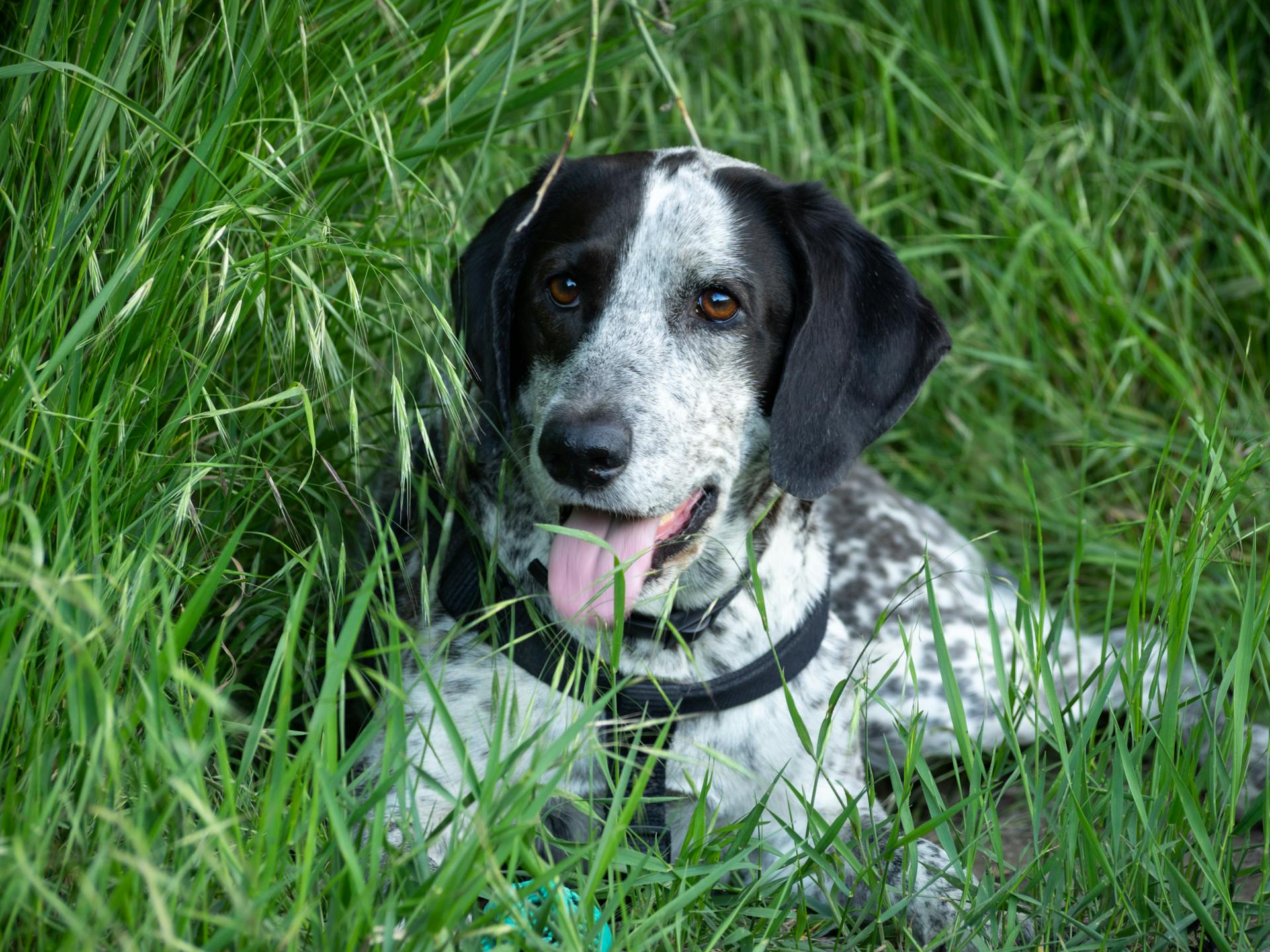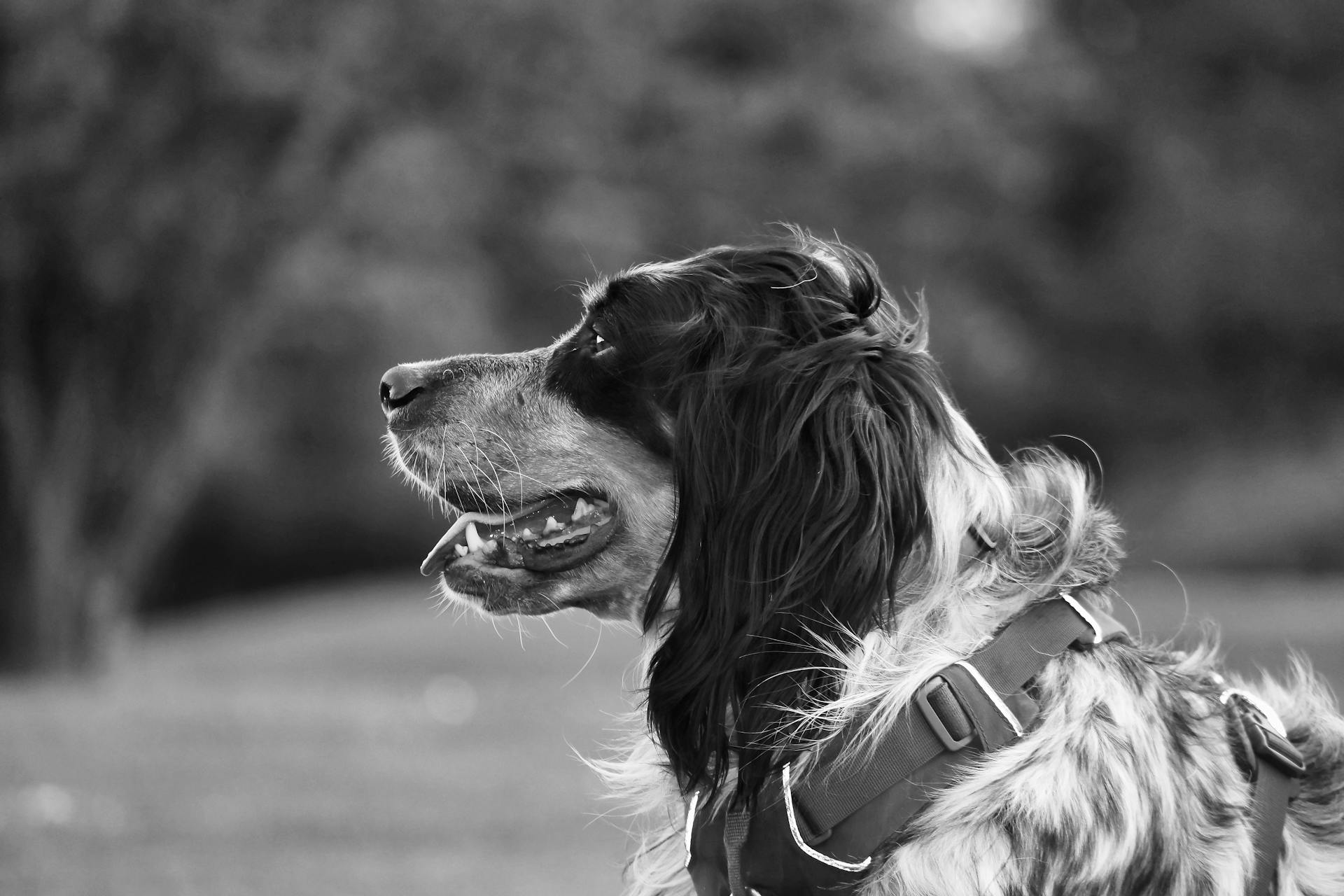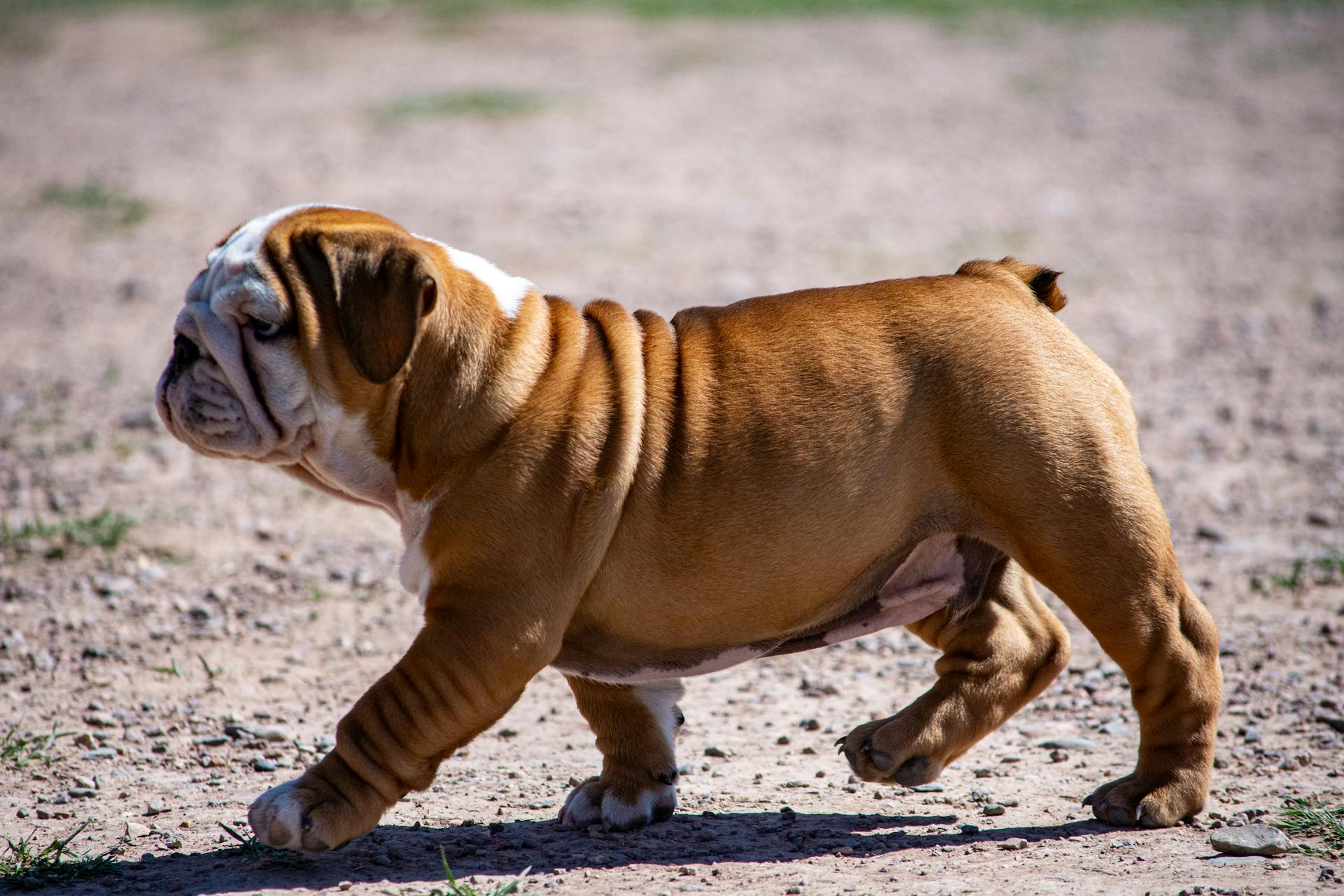
The English Pointer is a breed with a rich history that spans centuries. Its origins can be traced back to the 16th century in England.
The breed was developed from various pointing breeds, including the Old English Pointer and the Spanish Pointer. These early Pointers were highly valued for their hunting skills.
In the 18th century, the English Pointer became a popular breed among aristocrats, who prized them for their speed and agility. They were often used for hunting small game.
The breed's popularity continued to grow, and by the mid-19th century, the English Pointer had become a staple of English hunting culture.
Readers also liked: English Pointer Mixed Breed
History of the English Pointer
The English Pointer's origins date back to ancient times, with evidence suggesting they were known in ancient Egypt and the Middle Ages in Spain, France, and Italy. They were highly valued for their ability to point game, which was essential for hunting before the development of guns.
The breed was further developed in England, where Spanish Pointers were crossed with other breeds such as the Foxhound, Greyhound, and Bloodhound. This resulted in the modern English Pointer we know today, prized for its speed, agility, and endurance.
In the 1600s, early shotguns were introduced, and the Spanish Pointer became renowned for its ability to freeze in place, allowing the shooter to load the gun. This unique trait, known as "catalepsy", was a result of the dog's muscular rigidity and fixity of posture.
Becomes a Pure Breed
In England, once the Spanish Pointer arrived, other breeds were used in the manufacture of the Pointer (English) we know today.
By the mid-1800s, dog shows commenced, and a dog that could succeed in field trials and possess the elegance to compete in dog shows was sought.
Efforts were made to refine the Pointer, and its ability to find body scent in the air rather than foot scent on the ground became a priority.
The somewhat concave muzzle pointing upwards, commonly called the Arkwright head, came into vogue, which remains the hallmark of the Pointer (English) to this day.
The Pointer's ability to become cataleptic, even when backing another dog that is pointing game, was a notable feature.
This description from 'Idestone' (1872) captures the Pointer's unique gifts: "His airy gallop, his lashing stern, his fine range, his magnificent dead stop on game...".
History in Australia
The English Pointer has a rich history in Australia, dating back to 1864 when 26 Pointers competed at the first dog show held in Melbourne in April of that year.
It was a popular breed from the very start, with many more imports arriving between 1879 and 1909, as recorded in Tyzack's Annual.
These early dogs were valued for their functionality as field dogs, which contributed to their popularity.
"Heather Pardon" is one of the few Pointers whose pedigree was verifiable, with a 7-generation pedigree listed in Beilby's "The Dog in Australasia".
Today, Pointers continue to be a popular breed in Australia, with many beautiful show dogs competing in dog shows.
They remain a beloved breed, known for their beauty and usefulness in the field.
Here's an interesting read: History of Great Danes Dogs
History of the English Pointer
The English Pointer has a rich history that dates back to ancient times. They are believed to have originated in Spain, although their exact history is somewhat murky.
The breed was brought to England by Spanish Pointers, which were larger and heavier than the modern Pointer. These dogs were used to strengthen the pointing instinct in British dogs.
In England, the Pointer's appearance was developed through crosses with the Foxhound, Greyhound, Bloodhound, and later, various setters. Hunters sought to breed in the scenting ability and constitution of the Bloodhound, the speed and elegance of the Greyhound, and the scenting ability and endurance of the Foxhound.
The modern Pointer was developed in England, and its presence in America isn't really documented until the Civil War era. Sensation, a handsome lemon and white Pointer imported in 1876 from England, is the emblem of the Westminster Kennel Club.
The Pointer's ability to freeze in place for long periods of time was essential for hunting with early shotguns. This trait, known as "freeze" or "state of catalepsy", allowed the dog to stand perfectly still while the shooter loaded the gun.
The Pointer was recognized by the American Kennel Club in 1879, and the breed has been a favorite of many hunters and families ever since.
Additional reading: English Shepherd Dogs
The Today
The English Pointer is a stunning breed with a unique appearance.
Its symmetrical outline is a series of graceful curves, with a distinctly dish-faced muzzle. The muzzle is about the same length as the skull, with a well-defined stop.
The breed's skull is of medium breadth, with a prominent occipital bone, but flat cheekbones. The eyes are placed midway between the skull and muzzle.
The English Pointer's nose and eye rims should be a dark colour, but these may be lighter if the dog is white or has lemon colouring.
Curious to learn more? Check out: Pointer (dog Breed)
English Pointer Characteristics
The English pointer is a high-energy, intelligent dog with an independent streak. They are quick to pick up on cues and are very trainable dogs.
These dogs truly thrive with someone who can provide blocks of undivided attention. If you find yourself getting easily sidetracked during training sessions, the English pointer may not be the best match.
The English pointer tends to get along well with other dogs, especially if they are raised with them. They can get along with cats fine if they are introduced in puppyhood or well-trained.
Temperament
The English Pointer is a high-energy, intelligent dog with an independent streak. They are quick to pick up on cues and are very trainable dogs—you just need to put the time in and stay consistent with training.
They can get sidetracked during training sessions, so it's essential to provide blocks of undivided attention. If you get easily side-tracked, the English Pointer may not be the best match.
Pointers are generally great with other dogs, especially if they're raised with them. However, they might be tempted to chase smaller animals due to their hunting heritage.
It's crucial to remember that Pointers have a strong prey drive and should not be kept in a home with birds or rabbits. This is because they were bred to hunt these small animals.
Pointers are excellent watchdogs and will sound the alarm at anything out of the ordinary. They're also very protective of their property and will defend it if needed.
Related reading: Training an English Bulldog
To keep your Pointer happy and well-behaved, it's essential to provide them with adequate exercise and mental stimulation. Aim for one to two hours of exercise daily, and don't forget to challenge their brain with engaging activities.
Here are some key characteristics to keep in mind when living with an English Pointer:
- High-energy and intelligent
- Independent streak
- Quick to pick up on cues
- Needs consistent training
- Requires blocks of undivided attention
Appearance
The English Pointer is a dog built for speed and endurance. Their short-to-medium-sized ears hang close to their face, and they have a long muzzle that ends with a slightly upturned nose.
You'll often spot English Pointers with a bi-colored coat of white with liver, black, or orange-colored patches, and some may even have a tri-colored coat.
Their short coat requires minimal maintenance, needing only a weekly brush or wipe-down to stay clean and healthy.
Bathing your English Pointer every four to six weeks is recommended, but be careful not to overwash, as it may lead to dry skin.
A good Pointer can't be a bad color, with a striking coat of liver, black, orange, or lemon, and possibly white as a background. They may also have light or heavy speckles, or be tricolor.
Their coat is short, smooth, and shiny, and they shed lightly, making regular brushing a breeze.
Training and Care
English Pointers are intelligent dogs that train well with their handlers, particularly with consistency and positive training methods. Their independent nature can sometimes make training a bit challenging.
Pointers enjoy playing outside with their human family and do particularly well with obedience and agility training.
See what others are reading: How to Train English Springer Spaniel
Interesting Facts
English Pointers have a rich history, and here are some interesting facts that'll give you a better understanding of this breed.
English Pointers originated in Europe as versatile hunting dogs, with their ancestry dating back to the continent. They were bred to be athletic and agile, which is reflected in their sleek and strong physique.
Pointers are medium-sized dogs with a short and dense coat, often featuring distinct patterns like liver, lemon, or orange. Their elegant build is a testament to their agility and strength.
One of the most notable facts about English Pointers is that they were among the initial eight breeds officially registered in the United States. This is a testament to their popularity and importance in the world of dog breeding.
Here are some key differences between English Pointers and German Shorthaired Pointers:
English Pointers are known for their friendly and affectionate nature, making them a great fit for active families. They're also highly intelligent and eager to please, which means they're relatively easy to train.
Featured Images: pexels.com


